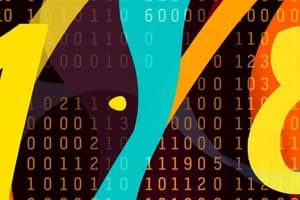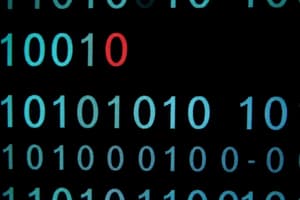Podcast
Questions and Answers
What is the binary representation of the decimal number 25?
What is the binary representation of the decimal number 25?
- 11001 (correct)
- 10100
- 10011
- 11100
The octal representation of the decimal number 25 is (32)8.
The octal representation of the decimal number 25 is (32)8.
False (B)
What is the hexadecimal representation of the decimal number 25?
What is the hexadecimal representation of the decimal number 25?
(19)16
A decimal fraction is converted to any other base by using multiplication by the ______.
A decimal fraction is converted to any other base by using multiplication by the ______.
Match the following decimal numbers with their equivalent representations in binary, octal, and hexadecimal:
Match the following decimal numbers with their equivalent representations in binary, octal, and hexadecimal:
What is the binary representation of (0.2345)10?
What is the binary representation of (0.2345)10?
(0.2345)10 is equal to (0.17004)8 in octal.
(0.2345)10 is equal to (0.17004)8 in octal.
What is the process of converting a decimal fraction to binary called?
What is the process of converting a decimal fraction to binary called?
The hexadecimal equivalent of (0.2345)10 is (0.______)16.
The hexadecimal equivalent of (0.2345)10 is (0.______)16.
What is the base of the Decimal Number System?
What is the base of the Decimal Number System?
Match the decimal fractions with their correct binary equivalents:
Match the decimal fractions with their correct binary equivalents:
The Octal Number System has a base of 16.
The Octal Number System has a base of 16.
Which of the following is the correct base for the octal number system?
Which of the following is the correct base for the octal number system?
What is the decimal representation of (456.41)8?
What is the decimal representation of (456.41)8?
In the conversion to hexadecimal, the digit 'A' represents 10.
In the conversion to hexadecimal, the digit 'A' represents 10.
What is the binary of the decimal number 234.625?
What is the binary of the decimal number 234.625?
In the Binary Number System, the base is ______.
In the Binary Number System, the base is ______.
Match the following number systems with their bases:
Match the following number systems with their bases:
Which of the following calculations represents (1FA.4C)16 in Decimal?
Which of the following calculations represents (1FA.4C)16 in Decimal?
(1101.01)2 equals 13.25 in Decimal.
(1101.01)2 equals 13.25 in Decimal.
How do you convert a Decimal integer to another base?
How do you convert a Decimal integer to another base?
Flashcards
Number System
Number System
A system for representing numbers using digits and a base (radix).
Decimal System
Decimal System
Number system with base 10, using digits 0-9.
Binary System
Binary System
Number system with base 2, using digits 0 and 1.
Octal System
Octal System
Signup and view all the flashcards
Hexadecimal System
Hexadecimal System
Signup and view all the flashcards
Conversion between systems
Conversion between systems
Signup and view all the flashcards
Data Representation
Data Representation
Signup and view all the flashcards
Base Conversion
Base Conversion
Signup and view all the flashcards
Decimal to Binary Fraction Conversion
Decimal to Binary Fraction Conversion
Signup and view all the flashcards
Decimal to Octal Fraction Conversion
Decimal to Octal Fraction Conversion
Signup and view all the flashcards
Decimal to Hexadecimal Fraction Conversion
Decimal to Hexadecimal Fraction Conversion
Signup and view all the flashcards
Binary to Octal Conversion
Binary to Octal Conversion
Signup and view all the flashcards
Binary to Hexadecimal Conversion
Binary to Hexadecimal Conversion
Signup and view all the flashcards
Decimal to Binary Conversion (Integer)
Decimal to Binary Conversion (Integer)
Signup and view all the flashcards
Decimal to Octal Conversion (Integer)
Decimal to Octal Conversion (Integer)
Signup and view all the flashcards
Decimal to Hexadecimal Conversion (Integer)
Decimal to Hexadecimal Conversion (Integer)
Signup and view all the flashcards
Decimal to Binary Conversion
Decimal to Binary Conversion
Signup and view all the flashcards
Decimal to Octal Conversion
Decimal to Octal Conversion
Signup and view all the flashcards
Decimal to Hexadecimal Conversion
Decimal to Hexadecimal Conversion
Signup and view all the flashcards
Decimal Fraction to Other Bases
Decimal Fraction to Other Bases
Signup and view all the flashcards
Number Base System
Number Base System
Signup and view all the flashcards
Study Notes
Introduction to Computer Systems: Data Representation
- Data comes in various forms: numbers, text, audio, images, video, and multimedia (combinations of these).
- All data types must be represented as 0s and 1s for computer storage and processing.
- Encoding is the method of representing data as 0s and 1s.
Number Systems
- Number systems (bases, or radices) use unique symbols (digits) to represent numbers.
- Digits have both a value and a positional value (based on its position). A number in a specific base is written as (number)base.
- Decimal (base 10) uses digits 0-9. A number like 5432 in base 10 can be calculated as 5 * 10^3 + 4 * 10^2 + 3 * 10^1 + 2 * 10^0 = 5432.
- Common number systems (bases) include binary (base 2), octal (base 8), decimal (base 10), and hexadecimal (base 16).
- Binary uses 0 and 1, Octal uses 0-7, Decimal uses 0-9 and Hexadecimal uses 0-9 and A-F.
- The number of possible values in N digits in base R is RN
Converting Decimal to Other Bases
- Integer conversion: Use integer division by the new base to find remainders.
- Fractional conversion: Multiply the decimal by the new base, retain the integer portion of the product, which becomes the next digit, and repeat.
Converting Between Binary, Octal, and Hexadecimal
- Shortcut methods exist for converting between these bases.
- Octal conversion uses groups of 3 binary digits.
- Hexadecimal conversion uses groups of 4 binary digits.
Binary Arithmetic
- Binary addition, subtraction and other operations are performed using the rules of base-2 arithmetic.
- Key rules are readily available for addition and subtraction.
- Overflow happens when the result of a calculation exceeds the available bits, leading to incorrect representation and potentially incorrect results.
Floating-Point Representation
- Represents real numbers as mantissa x baseexponent.
- Mantissa: The significant digits.
- Exponent: The power to which the base is raised.
IEEE Standard 754
- Standard format for representing floating-point numbers in computers.
- Standardized for single and double precision representations.
- Specific bit layouts define the sign, exponent, and mantissa portions.
Character Coding Schemes
- Codes like ASCII and Unicode represent characters, digits, and symbols as specific bit patterns.
- Each character has a unique bit pattern.
- EBCDIC and ASCII are commonly encountered character coding schemes.
- Unicode is compatible with most other codes allowing text to be exchanged between systems that may use different character codes.
Studying That Suits You
Use AI to generate personalized quizzes and flashcards to suit your learning preferences.




